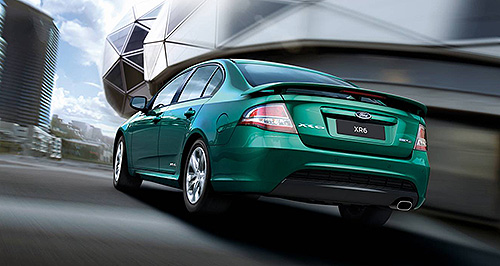News - Market Insight - Market Insight 2013Market Insight: High prices part of Falcon’s demiseRise and fall: The Falcon will leave Ford showrooms in 2016 as Ford exits Australian manufacturing. AAI data shows that although quality and spec have improved over the years, Falcon’s prices ‘kept rising as others stood still’. Data shows high prices of local cars over a long period have contributed to decline22 Jul 2013 By TERRY MARTIN NEW data suggests that price increases of the Ford Falcon and Holden Commodore relative to imported cars over a long period is a key, but largely unrecognised, factor behind their sales decline – and, in Ford’s case, its demise as a manufacturer in Australia by 2016. While much has been written about the reasons behind large-car sales diving dramatically in recent years, a price index compiled by specialist business and policy consultant Australian Automotive Intelligence (AAI) shows that Falcon and Commodore sedan prices – based on the entry-level six-cylinder automatic model – have risen markedly since the late 1990s, despite imported car prices falling. AAI principal Richard Johns described the pricing history of Falcon and Commodore as “the elephant in the room” when it comes to explaining their deep sales downturn over the past 10 years. “Falcon and Commodore prices shadowed the upward movement in imported car prices to the mid-1990s before both stabilised for a few years, but in the 2000s prices rose markedly despite falling import prices,” he said. “Both Ford and Holden markedly improved the quality and spec of their cars, with major gains in fuel economy in more recent years. But their prices kept rising as others stood still. This not only created sticker shock, but aggravated the residual problem. “Belatedly, Ford reduced the Falcon price at the end of 2011 with FG MkII, and Holden has followed with this year’s VF, but after the damage was done and most buyers had deserted.” Mr Johns said the Automotive Industry Authority (AIA) which implemented the ‘Button car plan’ under the Hawke Labor government in 1985 – an initiative designed to force Australian car-makers transition to lower levels of protection – monitored car prices over an eight-year period to 1993 and found local manufacturers had begun routinely raising prices. “The AIA monitored car prices from 1985 to 1993, when exchange rates were pushing up the prices of imported cars, and it criticised the local makers for raising prices at almost every opportunity rather than taking advantage of the competitiveness that exchange rate depreciation brought,” he said. “That type of critical overview would have been handy over the last decade or so.” Mr Johns emphasised that no one factor has been responsible for the decline in large-car sales, pointing to more obvious problems for local manufacturers such as the rise in popularity of imported SUVs, decline in residual values of large cars, and exchange rate and fuel price pressures. “Everyone has their pet theory on why sales of these once staple cars have fallen,” he said. “The flood of new model SUVs has provided more attractive alternatives to our large Commodore, Falcon and earlier the Magna and succeeding 380 residuals of the large cars have fallen dramatically over about the last 15 years, whereas smaller cars and SUVs have held their value much better the exchange rate has stabilised or reduced imported vehicles prices, and spec has improved and the fuel price rises of the 2000s made car owners much more sensitive to fuel economy, deserting the large sixes for more economical vehicles, including those with diesel engines. “Each of these factors and a few more have contributed significantly to the dramatic fall in large-car sales, resulting in the demise of Mitsubishi’s manufacturing and, along with the lack of significant exports, to Ford’s scheduled closure. “But the elephant in the room, as usual, has received little attention. It is the price of Falcon and Commodore.” In announcing its decision to quit car-making in Australia from 2016, Ford Australia said manufacturing locally was no longer viable “given the fragmented marketplace and the low model volumes that result”. Continuing to build the Falcon sedan, a two-door ute derivative and the Territory medium-sized SUV was, according to Ford, unsustainable without an export program. The company described Australia as “one of the most competitive and crowded automotive markets in the world” in which around 1.1 million sales are shared among more than 65 brands and 365 models. In 1996, Ford was the market leader and its Falcon, although second to Commodore as Australia’s top model, racked up 77,835 sales for the year. It was priced from $32,470 for the entry-level GLi (automatic). Last year, Ford sold 14,036 Falcons – down 25.1 per cent on 2011, despite the FG MkII series in full swing at the start of the year, complete with a $3055 price cut for the entry-level XT sedan that brought it back from $40,290 to $37,235. For the first half of this year, Falcon sales are down a further 25.9 per cent on the same period in 2012, with just 5070 units. Reaching even 10,000 for the full year looks to be a tough assignment, particularly now Ford Australia has made its future intentions painfully clear.  Read more28th of May 2013  Comment: Time for decision on Australia’s futureAustralia must decide whether or not manufacturing is important, then protect it28th of May 2013  Comment: Ford’s costly exitWe crunch the numbers on just how much it will cost Ford to stop building cars here23rd of May 2013  Ford to kill Falcon badge tooIconic Falcon badge to die alongside Ford’s Australian plants in 201623rd of May 2013  Ford Australia faces years of financial painFord set to remain in red in Australia until after switch to full importer in 201623rd of May 2013  End of the line for Ford AustraliaA dark day for Australian manufacturing as Ford confirms production to end in 2016 |
Click to shareMarket Insight articlesResearch Market Insight Motor industry news |


















Facebook Twitter Instagram